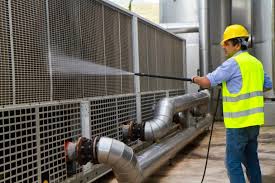Water blasting, or hydroblasting, is an effective cleaning method that utilizes high-pressure water streams to eliminate contaminants from surfaces. It’s commonly employed in industries like construction, manufacturing, and petrochemicals due to its precision and versatility. This article discusses water blasting applications, techniques, advantages over traditional cleaning methods, safety considerations, and future trends in the technology.
Overview of Water Blasting and Its Applications
Water blasting involves directing a high-pressure stream of water onto a surface to clean, strip, or prepare it for further processes. The pressure can range from 10,000 to over 40,000 pounds per square inch (psi), depending on the application. Unlike abrasive blasting methods that use sand or other particles, water blasting relies solely on water, making it a cleaner and more environmentally friendly option.
The applications of water blasting are diverse and include:
- Surface Preparation: Removing rust, paint, and other coatings from metal and concrete surfaces to prepare them for painting or coating.
- Industrial Cleaning: Cleaning equipment, tanks, pipes, and heat exchangers in industries such as oil and gas, power generation, and food processing.
- Debris Removal: Clearing blockages in sewer lines, drains, and other conduits.
- Concrete Demolition: Cutting and removing concrete without damaging the surrounding structures.
Different Types of Water Blasting Techniques
Water blasting techniques vary based on pressure levels, nozzle design, and specific applications. Some of the common types include:
Low-Pressure Water Blasting
Low-pressure water blasting, typically under 10,000 psi, is used for general cleaning tasks such as washing vehicles, buildings, and sidewalks. It is effective for removing dirt, grime, and algae without damaging the surfaces.
High-Pressure Water Blasting
High-pressure water blasting, ranging from 10,000 to 25,000 psi, is used for more demanding cleaning and surface preparation tasks. It can remove tough coatings, rust, and industrial grime from metal surfaces, making it ideal for maintenance and refurbishment projects.
Ultra-High-Pressure Water Blasting
Ultra-high-pressure water blasting, exceeding 25,000 psi, is employed for the most challenging cleaning and cutting applications. It is capable of cutting through concrete, steel, and other hard materials with precision, making it suitable for demolition, hydrodemolition, and specialized industrial cleaning.
Abrasive Water Blasting
Abrasive water blasting combines high-pressure water with abrasive materials such as sand or garnet. This technique enhances the cutting and cleaning power of water blasting, making it effective for removing heavy coatings, corrosion, and scale from surfaces.
Benefits of Using Water Blasting Over Traditional Methods
Water blasting offers several advantages over traditional cleaning and surface preparation methods:
- Environmentally Friendly: Water blasting uses water as the primary medium, reducing the need for chemicals and minimizing environmental impact.
- Precision: The high-pressure water stream can be precisely controlled, allowing for targeted cleaning and cutting without damaging surrounding areas.
- Versatility: Water blasting can be used on a wide range of materials, including metals, concrete, and composites, making it suitable for diverse applications.
- Efficiency: The high-pressure water stream effectively removes contaminants and coatings, reducing cleaning and preparation times.
- Safety: Water blasting generates minimal dust and airborne particles, improving safety for operators and reducing the risk of respiratory issues.
Safety Considerations
While water blasting is generally safer than abrasive blasting, it still requires strict adherence to safety protocols to prevent accidents and injuries:
- Protective Gear: Operators should wear appropriate personal protective equipment (PPE), including waterproof suits, gloves, eye protection, and helmets with face shields.
- Training: Proper training is essential to ensure operators understand how to safely handle high-pressure equipment and respond to emergencies.
- Equipment Maintenance: Regular inspection and maintenance of water blasting equipment are crucial to prevent malfunctions and ensure safe operation.
- Safety Barriers: Establishing safety barriers and clear zones around the work area can protect other workers and bystanders from high-pressure water jets and debris.
Future Trends in Water-Blasting Technology
The future of water blasting technology is shaped by ongoing innovations aimed at improving efficiency, safety, and environmental sustainability:
- Automation and Robotics: The integration of automated and robotic systems in water blasting can enhance precision, reduce human exposure to hazards, and increase productivity.
- Advanced Nozzle Designs: Innovations in sapphire nozzle technology can optimize water flow and pressure distribution, improving cleaning and cutting performance.
- Eco-Friendly Solutions: Continued development of eco-friendly water blasting methods, such as recycling water and minimizing wastewater generation, will further reduce environmental impact.
- Smart Monitoring Systems: The use of sensors and IoT technology to monitor equipment performance and detect issues in real-time can enhance safety and maintenance efficiency.
Conclusion
Water blasting is a powerful and versatile technique that offers numerous benefits over traditional cleaning and surface preparation methods. With ongoing advancements in technology, water blasting is set to become even more efficient, precise, and environmentally friendly, making it an indispensable tool for various industries.



